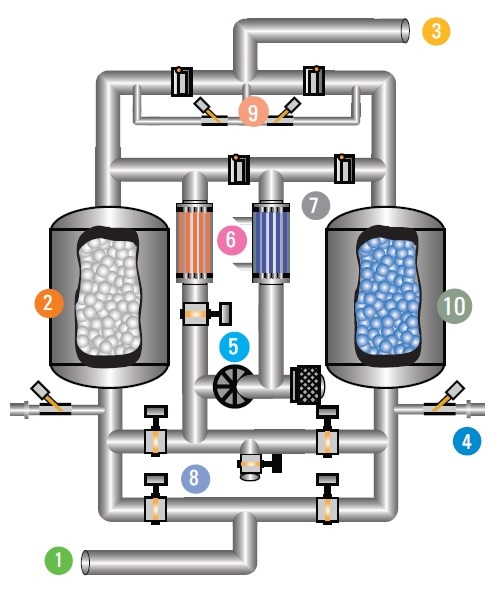AZP Series Zero Purge Heated Regenerative Desiccant Dryers
The Aircel AZP (800 – 10,000 scfm) utilize externally heated atmospheric air for regeneration of the desiccant bed. This eliminates the use of compressed purge air for regeneration resulting in an overall reduction in the cost of operation. In the HRS-L the cool-down of the regenerated bed is assisted by a water cooled heat exchanger that further reduces compressed air usage. The result, only a small fraction of process air is consumed during depressurization of the offline tower. This amounts to an average process air use of < .05% of the rated capacity of the dryer and zero dew point spike providing a -40F dew point. Our zero purge dryers help to ensure optimal performance and cost savings.
Understanding Zero Purge Dryers
A zero purge dryer is a type of desiccant air dryer that eliminates the need for using compressed air during the regeneration process. Instead, it uses externally heated atmospheric air, which significantly reduces overall compressed air consumption. The zero purge regenerative dryer works by utilizing a heat exchanger to cool down the desiccant bed after regeneration, ensuring efficient and cost-effective operation with minimal air loss. This method maintains a consistent dew point and enhances the dryer’s reliability, making it an ideal choice for professionals seeking efficient air-drying solutions.

- Benefits
- Features
- Optional Features
- How it Works
- Brochure
- Zero purge air consumption.
- Built-in energy management controls.
- Heating and cooling cycles are terminated early when set temperature is reached, saves energy and further reduces cost of operation
- Low pressure drop design for energy savings.
- Maximum desiccant volume for long life.
- High quality components for reliable service and long life.
- Unique HRS-L parallel flow to reduce or eliminate dew point and temperature spikes.
- Small footprint saves valuable floor space.
- Water-cooled heat exchanger.
- Corrosion resistant finish.
- NEMA 4 electrical enclosures.
- Allen Bradley PLC control system.
- Common alarm / pilot light.
- Switching Alarm (using pressure switch logic).
- High performance butterfly and stainless steel valves.
- Highly reliable angle body piston valves for depressurization.
- NEMA 4X (corrosive protection) electrical construction.
- NEMA 7 (explosion proof) electrical construction.
- -100°F pressure dew point.
- Low ambient temperature package.
- Dew point monitor.
- Demand cycle control with dew point monitor.
- Pre-piped filters and by-pass valve packages.
- Visual moisture indicator.
- High outlet temperature alarm.
- Low ambient temperature alarm.
The HRS-L heated blower purge dryer incorporates a water-cooled heat exchanger which eliminates the need for purge air during the cool-down period. At the end of the heat cycle, a series of valves open or close creating a closed-loop between the air blower and vessel.
- Wet compressed air, controlled by butterfly valves, enters the base of the on-line vessel (prefilter recommended).
- As the compressed air passes through the desiccant bed, moisture is removed, lowering the dew point to -40º F.
- Dry compressed air exits the top of the vessel, passes through a check valve and flows downstream to the use point (afterfilter recommended).
- When the desiccant bed becomes saturated with moisture, it goes off-line and depressurizes to ambient through an angle-seat globe valve. A muffler attenuates the noise of depressurization.
- After the off-line vessel has depressurized, a blower draws in ambient air for regeneration.
- The ambient air is heated to 400º F, giving it the energy required to initiate and accomplish desorption, after which it passes through a check valve and enters the top of the regenerating vessel.
- As the hot ambient air passes through the desiccant bed, water molecules are released from the surface of the desiccant and enter the airstream.
- At the end of the heating phase the heater is turned off and regeneration air is directed through a water cooled heat exchange.
- The blower circulates the cooled air back through the vessel.
- As the cooled air passes through the desiccant bed, it picks up heat energy which is removed from the system via the water-cooled heat exchanger. The closed-loop cycle continues until the bed temperature is lowered to its operation point without the use of purge air.
